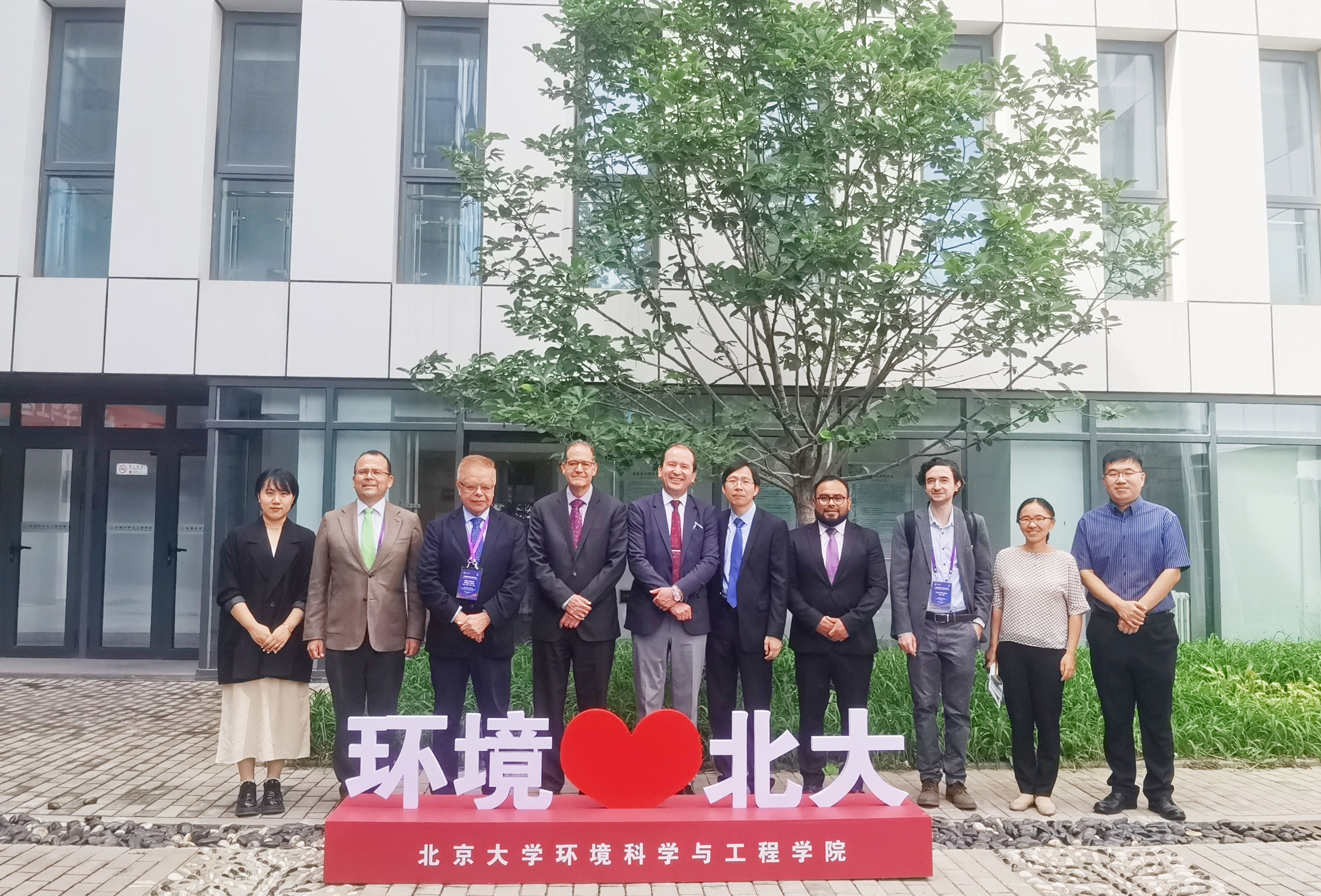Why Study Environmental Engineering in China:China offers cutting-edge environmental technologies, vast research opportunities, and unique ecological challenges.
Table of Contents

Introduction
The world stands at a crucial juncture, where the challenges posed by environmental degradation demand innovative solutions. As countries rally to combat climate change, restore ecosystems, and ensure a sustainable future, the role of environmental engineering becomes ever more paramount.
The Global Significance of Environmental Engineering
Environmental engineering plays a pivotal role in addressing some of the planet’s most pressing challenges, from water pollution to air quality control. At the heart of this discipline lies the pursuit of solutions that merge science and engineering principles to improve the natural environment. The field not only ensures clean water, air, and land for human habitation but also seeks to remedy the adverse environmental effects of human activity.
Key statistics highlighting its significance include:
- Around 785 million people lack a basic drinking water service, emphasizing the importance of water purification techniques.
- Air pollution contributes to nearly 7 million deaths worldwide annually, underscoring the necessity of efficient air quality systems.
- With the global population projected to reach 9.7 billion by 2050, waste management systems will need to handle an estimated 3.4 billion tons of waste annually.
China’s Unique Position in Global Environmental Challenges
China, as the world’s most populous country and second-largest economy, bears a significant share of global environmental challenges. However, with challenges come opportunities. In recent years, China has emerged as a global leader in environmental engineering solutions, with significant investments in research and green technologies.
Noteworthy developments from China include:
- The launch of the world’s largest floating solar power plant in Anhui province, with a capacity of 40 megawatts and an efficiency rate of 15%.
- The country’s ambitious afforestation project, which aims to increase its forest coverage rate to 26% by 2030. The project already saw the planting of 33.8 million hectares of forests between 2016 and 2020.
- Beijing’s transformation from being one of the most polluted cities to meeting national air quality standards in 2019, thanks to the city’s stringent emission norms and the introduction of cleaner technologies.
Historical Context
China’s Industrial Growth and Environmental Impacts
China’s meteoric rise as an industrial powerhouse began in the late 1970s with its economic reform. By the early 2000s, China had transformed from an agrarian economy to a global industrial leader. This rapid industrialization brought along impressive economic gains, lifting millions out of poverty. However, the rapid development came at an environmental cost.
Some of the key statistics and impacts include:
- China became the world’s top carbon emitter in 2007, overtaking the US, with emissions reaching 10.065 gigatons in 2018.
- In 2016, it was estimated that nearly 1.1 million premature deaths in China were attributed to air pollution.
Legacy of Environmental Policies in China
Recognizing the detrimental impacts of unchecked industrial growth, China’s government began implementing a series of environmental policies to mitigate the harm and pave the way for sustainable development.
Key policies and their effects include:
- The Air Pollution Prevention and Control Action Plan (2013): Aimed to reduce the levels of fine particulate matter (PM2.5) in cities by up to 25% by 2017. As a result, Beijing saw a significant drop in PM2.5 levels by 35% in 2017 compared to 2013 levels.
- The 13th Five-Year Plan for Ecological and Environmental Protection (2016): With a budget of $275 billion, it emphasized the reduction of pollutants, preservation of natural ecosystems, and the promotion of green industries.
- China’s commitment to the Paris Agreement: In 2020, China pledged to reach peak carbon emissions before 2030 and achieve carbon neutrality by 2060. This commitment, given the scale of China’s economy, is a massive step toward global climate mitigation.
Ten of the most popular universities in China for studying Environmental Engineering
| Rank | University Name | Location |
|---|---|---|
| 1 | Tsinghua University | Beijing |
| 2 | Peking University | Beijing |
| 3 | Zhejiang University | Hangzhou |
| 4 | Shanghai Jiao Tong University | Shanghai |
| 5 | Fudan University | Shanghai |
| 6 | Tongji University | Shanghai |
| 7 | Nanjing University | Nanjing |
| 8 | Beijing Normal University | Beijing |
| 9 | Wuhan University | Wuhan |
| 10 | Xiamen University | Xiamen |
Rapid Technological Advancements
China’s Pioneering Role in Environmental Technologies
Here are some key areas where China shines:
- Solar Energy: China dominates the global solar panel market, producing over 70% of the world’s solar panels.
- Electric Mobility: China hosts the world’s largest electric vehicle market, with over 1.2 million electric vehicles sold in 2020 alone. Companies like BYD and NIO are leading the way with innovative designs and efficient battery technologies, boasting energy densities of over 160 Wh/kg and reducing charging times to under 30 minutes for a range of 500 km.
- Waste-to-Energy: China has invested heavily in converting urban waste into energy.
Case Studies: Innovations from Chinese Universities and Corporations
- Tsinghua University’s Air Quality Improvement Research: Using advanced algorithms and AI, Tsinghua University researchers created a system to forecast air pollution patterns.This tool aids policymakers in implementing timely measures, improving air quality indexes by up to 15% in test regions.
- Alibaba’s Cloud-based Water Quality Monitoring: Leveraging IoT, Alibaba launched a real-time water monitoring system across multiple Chinese rivers. This system measures parameters like pH, turbidity, and chemical pollutants, allowing for timely interventions. In pilot regions, water quality improved by 20% within a year.
- Sinopec’s Carbon Capture Technology: Sinopec, a leading Chinese energy company, developed an efficient carbon capture and storage (CCS) technique.
Strong Governmental Support and Funding
National Policies Promoting Environmental Protection
The Chinese government’s emphasis on environmental protection and sustainable development is evident in its successive five-year plans and numerous policies. The government strongly supports green initiatives, acknowledging the clear connection between a healthy environment and a prosperous economy.
Key national policies include:
- The 13th Five-Year Plan: This policy document prioritized green initiatives, outlining specific goals for reducing pollutants, developing green infrastructure, and cutting carbon intensity.By 2020, the goal was to reduce sulfur dioxide and nitrogen oxide emissions by 15% and 10%, respectively.
- The China Emissions Trading System (ETS): Launched in 2017, ETS is one of the world’s largest carbon trading systems. Designed to cap carbon emissions from power plants, the system covers over 3 billion tons of CO2 emissions. Plants exceeding their quotas can buy credits, incentivizing efficiency improvements. As of 2022, the average price per carbon credit stood at $6, encouraging industries to adopt greener technologies.
- Green Finance Guidelines: Introduced in 2016, these guidelines encourage banks and financial institutions to prioritize green projects. By 2021, green loans exceeded $1 trillion, with a default rate of just 0.39%, showcasing the profitability of green investments.
Investment in Research and Development
For China, investing in research and development (R&D) is not just a strategy; it’s a necessity. As the country grapples with its unique environmental challenges, indigenous solutions become crucial.
Investment details and impacts:
- Financial Allocation: China’s R&D expenditure has been on a steep upward trajectory. In 2020, the R&D budget exceeded 2.4% of its GDP, amounting to over $370 billion. Of this, approximately 10% was earmarked for environmental technologies.
- Green Tech Parks: Across cities like Beijing, Shanghai, and Shenzhen, specialized tech parks focus solely on green technologies. These hubs house startups, research institutions, and corporations, fostering collaboration and innovation. For instance, the Beijing Green Tech Park has incubated over 200 startups since its inception in 2018.
- Collaborative Initiatives: Recognizing the global nature of environmental challenges, China has partnered with countries, academic institutions, and international organizations. The China-EU Water Platform, established in 2012, is one such initiative focusing on water management solutions.

China’s Unique Environmental Challenges
Urban Air Pollution: Causes and Mitigation
China’s rapid industrialization, paired with its high population density in urban areas, has given rise to severe air pollution challenges. Cities like Beijing, Tianjin, and Shijiazhuang frequently suffer from smog, harming residents’ health and daily lives.
Causes:
- Industrial Emissions: Heavy industries, especially coal-based power plants and steel manufacturing units, release significant amounts of particulate matter and gaseous pollutants.
- Vehicular Emissions: With over 250 million cars on the road as of 2020, the sheer volume of vehicular emissions, especially from diesel engines, contributes heavily to urban air pollution.
- Construction Activities: The rapid pace of urban development results in dust and particulate matter from construction sites.
Mitigation:
- Transition to Renewable Energy: By 2022, China aims to generate 20% of its total energy from renewable sources, reducing dependence on coal and cutting down emissions.
- Green Transportation: The introduction of electric buses, incentives for electric vehicles, and the expansion of metro networks in over 40 cities have curbed vehicular pollution. The Beijing metro network alone, spanning over 699 km, has diverted millions from private cars, reducing annual emissions by an estimated 100,000 tons.
- Air Quality Monitoring Systems: Cities like Shanghai, using IoT and big data, have set up real-time air quality monitoring and alert systems for swift actions during high pollution periods.
Water Scarcity and Pollution: From Source to Solution
China, 20% of the world’s population but only 7% of its freshwater, faces severe water scarcity and pollution.
Challenges:
- Industrial Waste: Industries along the Yangtze and Yellow rivers have historically discharged untreated waste, leading to widespread water contamination.
- Over-Extraction: Excessive groundwater extraction for agriculture and industrial purposes has led to falling water tables, with Beijing’s groundwater depleting at a rate of about 1 meter per year.
Solutions:
- South-North Water Transfer Project: One of the most ambitious engineering projects, this aims to divert 44.8 billion cubic meters of water annually from the south to the parched north.
- Wastewater Treatment Plants: By the end of 2021, over 4,000 wastewater treatment plants were operational in China, treating an estimated 150 million cubic meters of water daily. For instance, the Qingdao wastewater treatment plant, with a daily capacity of 1 million cubic meters, has consistently achieved a water purity level of 98%.
Waste Management: Strategies and Implementation
China generates an estimated 220 million tons of urban waste annually. Managing this volume efficiently is both a challenge and a priority.
Challenges:
- Landfills: Over 90% of China’s waste went to landfills in 2000, leading to land scarcity and environmental degradation.
- Waste Segregation: Historically, waste segregation at the source was not a common practice, complicating recycling efforts.
Implementation:
- Waste-to-Energy Plants: As previously mentioned, China operates over 300 waste-to-energy plants, converting urban waste into electricity and reducing landfill dependence.
- Recycling Initiatives: Cities like Suzhou have achieved a recycling rate of over 50% through comprehensive waste segregation programs and public awareness campaigns.


